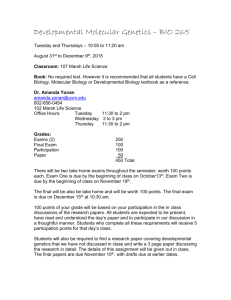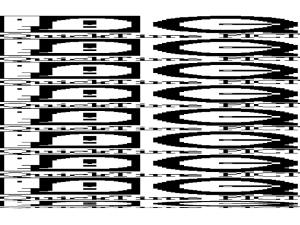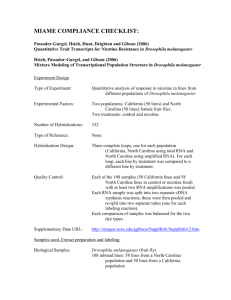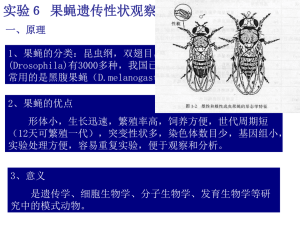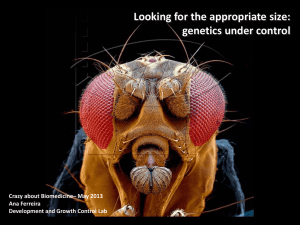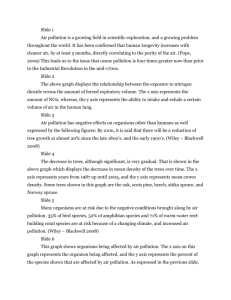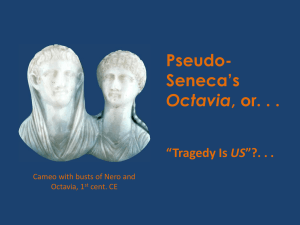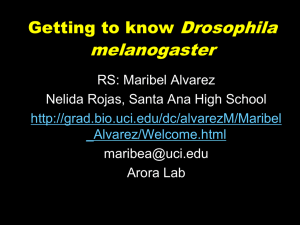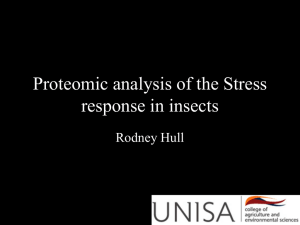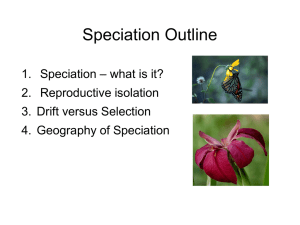The Effect of Juices on the Longevity of Drosophila melanogaster
advertisement
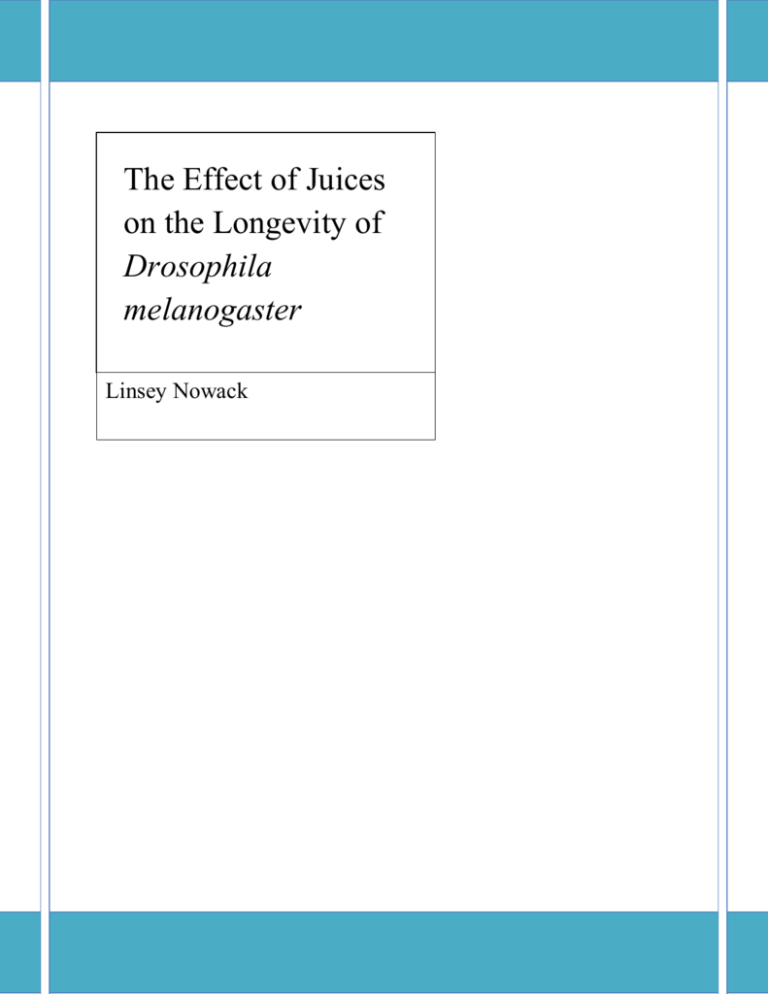
The Effect of Juices on the Longevity of Drosophila melanogaster Linsey Nowack Nowack Table of Contents Acknowledgments………………………………………………………………………………… 1 Purpose and Hypothesis…………………………………………………………………………... 2 Review of Literature……………………………………………………………………………… 3-5 Materials and Methods of Procedure……………………………………………………………...6-11 Results…………………………………………………………………………………………….12-17 Data Tables……………………………………………………………………………….12-14 T Test Results…………………………………………………………………………….15 Graphs……………………………………………………………………………………16 Conclusion………………………………………………………………………………………...19-22 Reference List…………………………………………………………………………………….23-24 Nowack Acknowledgments I would like to thank my family for their unyielding support, especially my older sister, Lea. In addition, I’d like to thank Stevenson High School for providing equipment such as test tubes and test tubes stands. Finally, I’d like to thank Mrs. Regussa and my sponsor, Mrs. Palffy. No words can express the gratitude I feel towards them for guiding me through this wonderful, scientific expedition. Nowack Purpose The purpose of this experiment is to test the Free Radical Theory along with the properties of various fruits and vegetables operating the life span of Drosophila melanogaster. The Free Radical Theory relies on antioxidants found in consumed foods to prevent/decelerate oxidative stress on a cell’s organelles and DNA. Therefore, by providing D. melanogaster with foods- consisting of juices and the standard D. melanogaster food mixture- of various antioxidant properties, the Drosophila melanogaster with greater supply of antioxidants would, in theory, live longer. Hypothesis If D. melanogaster were provided diets of D. melanogaster mix and carrot juice, mango juice, peach juice, pear juice, or water, then the D. melanogaster given food with carrot juice will have the longest lives. Nowack Review of Literature Drosophila melanogaster have a variety of roles ranging from pesky household annoyances to one of the most beneficial organism in biological research. These insects slapped for hovering around human food were once studied by Thomas Hunt Morgan, in 1910, to recognize many main rules of heredity such as the use of sex-linked genes as well as dominant and recessive traits (Wade 2000)(“Thomas” 2006). Due to the D. melanogaster’s simplicity, it was the first organism to have its entire genetic code mapped lead by Dr. J. Craig Venter of the Celera Corporation in December of 1999 (Wade 2000). Today, D. melanogaster are still the one of the most popular organisms for genetic research. Drosophila comes from the term “lover of dew” because D. melanogaster can be found around decaying organic material. They like to lay their eggs on the slightly old fruit so the larvae can use the old fruit as a source of nutrition after hatching (Miller 2000). Female D. melanogaster live an average 26 days while males live around 33 days in lab conditions. They prefer a temperature of 25°C which will take around 10 days for the D. melanogaster to mature from egg to adult. Anything below 25°C will slow the process (The University of Arizona Center for Insect Science Education Outreach 2001). D. melanogaster remain eggs for the first 22 hours of their lives. Once hatching from its egg, the insect enters a larval stage which lasts about 4 days (The University of Arizona Center for Insect Science Education Outreach 2001). Larvae are usually small, thin, and a pale white with black tips. They can be found inside and on top of the food (“Drosophila” 2011). Afterwards, the larvae harden and become pupas. In the pupa stage, they enclose themselves in small brown cocoons. After 4-6 days, the D. melanogaster enter adulthood (The University of Arizona Center for Insect Science Education Outreach 2001). In 2010, another experiment was conducted by the Laboratory of Experimental Gerontology, National Institute on Aging, with D. melanogaster regarding their longevity. It focused on what foods placed in the D. melanogaster diet could elongate the insect’s lifespan. Past experiments have suggested Nowack diets of extracts from blueberries, acai fruit pulp, or even cranberries combined with oregano could extend the lives of D. melanogaster. This experiment, in particular, questioned the qualities of nectarines. As a subspecies of peaches, nectarines contain “a number of nutritionally important heath-promoting ingredients, including dietary fiber, meaningful amounts of vitamin C and and β- carotenoids, and high contents of polyphenols (Boyd 2011).” In the procedure, 10 D. melanogaster were placed per vial. The males and females were allowed to mate and then were separated into different vials. The number of eggs produced as well as the amount of movement was measured. It’s “findings suggest that nectarine can promote longevity without affecting food intake, and this life span extension depends on gender and dosage of nectarine (Boyd 2011).” The Laboratory of Experimental Gerontology was testing the possible influence of free radicals. This theory, hypothesized in 1956 by Denam Harman, relies on the idea that aging is caused by free radicals creating oxidative stress on macromolecules in the cell (Panno 2005)(Boyd 2011). Free radicals are molecules released by the mitochondria with an unpaired electron. One of the most dangerous free radical is the oxygen free radical due to its ability to take an electron from almost any molecule in the cell. Upon doing so, the free radical can cause a “reaction of destabilized molecules reacting with other molecules to form new free radicals and a variety of potentially dangerous compounds (Panno 2005).” In order to defend itself from such damage, cells contain the enzyme superoxide dismutase (SOD). It neutralizes newly made oxygen free radicals. However, there are always some oxygen free radicals that escape the watchful of eye of SOD and their damage cumulates overtimes thus creating oxidative stress. By consuming foods of antioxidant qualities, one could, in theory, prevent some oxidative damage and live longer. Genetic studies of Saccharomyces cereviside, Musca domestica, Drosophila melanogaster, and Mus musculus have found many genes engaged in changing their suitor’s lifespan (Panno 2005). Antioxidants can be found in a variety of foods and in different forms. Vitamin A and Vitamin C are antioxidants. A past experiment’s results even suggested Vitamin E can protect lab animals from biochemical threats such as cigarette smoke and metallic poison. However, it has difficulty entering the mitochondria of a cell and therefore can’t defend that organelle’s DNA (Kidd 2006). The following Nowack experiment, instead of testing nectarine, experiments with diets with Daucus carota, Mangifera, Prunus persica, or Pyrus juice. D. carota are sometimes considered the superfood of vegetable. In juice form, one cup “can offer a quick energy boost with its 2 grams of protien, 2 grams of fiber, and only 94 calories. The beta carotene fix measures up 25,833 IU along with a healthy dose of vitamins B1, B2, B3, B6 and 9 mcg of folic acid (And 2011).” “Beta carotene is a strong, natural antioxidant that helps functions of reproductions, vision, maintenance of epithelial integrity, growth, and development (Power 2011).” One cup of D. carota juice also contains 56.6 mg of calcium and 689 mg of potassium along with 20.1 mg of vitamin C and a little of iron and zinc (And 2011). Mangifera, like D. carota, is another powerful food packed with many enzymes that help defend itself from insects. These enzymes, in humans, stimulate metabolism and cleanse the intestinal tract (Mango 2011). In addition “studies have shown that foods containing phenolic compounds have powerful antioxidant, anticancer, anticardiovascular abilities. [Mangifera] possess the phenols quercetin, isoquercitfin, astragalin, fiseti, gallic acid, and methylgallat (Mango 2011).” Furthermore, Mangifera also contain lots of beta carotene realm, potassium, magnesium, vitamin C, and impressive numbers of vitamins B1, B2, B3, and B6 with a bit of zinc, iron, and calcium (Mango 2011). With high quantities of carotenes and known anticancerous properties, P. perisca juice was chosen to be tested in this experiment because it was similar to the Laboratory of Experimental Gerontology’s experiment involving nectarines, a subspecies of peaches (Properties 2011). P. perisca contain lots of vitamin A, B vitamins, vitamin C, calcium, fiver, potassium, and a pinch of zinc along with beta carotene (It’s 2011). Last but not least, Pyrus is known to be high in fiber with fair amount of vitamins A, C, K, B2, B3, and B6. Like P. perisca, Pyrus contain calcium, magnesium, potassium, copper, and manganese. It also contains another antioxidant by the name of quercetin in its skin which “helps prevent cancer and artery damage that can lead to help problems (Pear 2011).” Nowack Materials and Methods of Procedure Materials: 1 packet of Ward’s package with Drosophila melanogaster and food 5 400ml plastic containers- with lids 1 role of labeling tape 150 thin test tubes 76 cotton balls 5 large test tubes with personal sponge corks 1 black Sharpie marker 1 red Crayola marker 1 green Crayola marker 1 liter carton of Hortex: Vitaminka carrot juice 1 liter carton of Nectar Hekmap: Florina peach juice 1 liter carton of Premium: Fresh Nectar pear juice 1 liter carton of Nectar Hekmap: Florina mango juice 1role of paper towels- perforated every 25 cm 6 plastic spoons 1sheet of paper 1 pair of scissors 18 wooden test tube racks that hold 6 test tubes 1 rack that holds 8 test tubes by 10 test tubes 1 graduated cylinder 1 napkin 1 functional sink Nowack 1 bottle of Dial Complete: antibacterial foaming hand soap Water 1 plastic bin 1 test tube brush 14.78 milliliters of Clorox bleach Sanitizing test tubes 1. Gather all large and small test tubes that will be used in the experiment 2. Remove the test tubes’ caps or corks and set them aside 3. Fill a plastic bin with 3.78541178 liters of warm water 4. Pour 14.7867648 milliliters of bleach into the plastic bin and stir so the bleach dissolves into the water 5. Wait 2 minutes before placing the test tubes in the bin 6. Let test tubes soak for 15 minutes before removing them from the plastic bin 7. Squirt some soap into each test tube and brush the inside using a test tube brush 8. Rinse test tubes with tap water and set them on wooden test tube racks to dry 9. Place paper towels underneath the test tube racks to prevent puddles of water 10. Drain bleach and water from the plastic bin into a sink Preparing D. melanogaster food All food is made at the same time and then stored in a refrigerator at 6°C to prevent the growth of bacteria or fungi. 1. Gather 5 400ml plastic containers and their lids and place them in a line on a flat surface 2. Write ‘carrot’ on a piece of labeling tape using a black Sharpie marker, cut it from the role of labeling tape, and insert it on the first container 3. Do the same for the second container, but this time label it ‘mango’ Nowack 4. Label the third container ‘peach’, the fourth container ‘pear’, and the last container ‘control’ 5. Cut open the top of Ward’s D. melanogaster food bag and divide the food equally among the 5 400ml plastic containers 6. Measure the amount of food in one container 7. Pour Hortex: Vitaminka carrot juice in the first container labeled ‘carrot’ with the of amount food and the amount of juice in a 1:1 ratio 8. Pour Nectar Hekmap: Florina mango juice in the second container labeled ‘mango’ with the amount of food and the amount juice in a 1:1 ratio 9. Pour Nectar Hekmap: Florina peach juice in the third container labeled ‘peach’ with the amount of food and the amount juice in a 1:1 ratio 10. Pour Premium: Fresh Nectar pear juice in the fourth container labeled ‘pear’ with the amount of food and the amount of juice in a 1:1 ratio 11. Pour water in the last container labeled ‘control’ with the amount of food and the amount of water in a 1:1 ratio 12. Use a plastic spoon to mix the containers (each container gets its own plastic spoon) 13. Once all the foods have been mixed, place a lid on each container 14. Store all containers and cartons of juice in a refrigerator at 6°C 15. Wash all the plastic spoons that were used to mix the foods with soap and water until no food remains are visible on the spoons 16. Dry the spoons using a napkin and place them alongside the containers in the refrigerator Isolating adults from children The goal is to separate the adults from the pupas, larvae, and eggs because data will later be gathered from the pupa once they’ve changed into adults. All D. melanogaster are stored at 23°C. Nowack 1. Gather 1 large test tube with a sponge cap, 1 sheet of paper, the ‘control’ container of D. melanogaster, 1 plastic spoon from the refrigerator, and the test tube holding the Ward’s D. melanogaster 2. Use the spoon to transfer one spoonful of control food from the control container into the empty large test tube (Test Tube B) 3. Fold sheet of paper into the shape of a funnel 4. Place smaller end of the funnel into Test tube A so that the larger opening of the funnel faces upward 5. Lightly shake the test tube holding the D. melanogaster (Test Tube A) so that all the adult D. melanogaster fall to the bottom of the test tube 6. Quickly remove the cork from Test Tube A and turn the test tube upside down over the large opening of the tunnel 7. Ensure there are no gaps for the insects to escape between either test tubes and the funnel by placing one hand on the spot where Test Tube A and large opening to the funnel connect in order to hold the two together and another hand on the spot where the small opening to the funnel and Test Tube B connect 8. Lightly shake/tap the test tubes connected by the funnel against the hard surface bellow so the adult D. melanogaster fall through the funnel opening and into Test Tube B- this will also prevent the adults from crawling back up the funnel once they’ve fallen into Test Tube B 9. After all the adults are all in Tube B, quickly set Test Tube A reside up again on a hard surface, remove the funnel from Test Tube B, and place a sponge cork on Test Tube B 10. Plug Test Tube A with its own cork 11. Check to make sure no D. melanogaster are stuck in the funnel- if there are, use the plastic spoon to move them into Test Tube B (remember to shake test tube so adults fall to the bottom before removing cork to prevent any from escaping) Nowack Relocating newly transformed pupas This is a daily process performed until all 150 small test tubes are filled. 1. Check to see if any pupas have changed into adults in Test Tube B 2. If so, gather one empty large test tube and its sponge cork 3. Repeat steps from the “Isolating adults from children” section- the goal is again to separate the adults from the pupas, larvae, and eggs except: Do not put control food in the new large test tube (Test Tube C) because it isn’t the adults’ permanent home 4. After moving the new adults to their own test tube, remember to cork both test tubes B and C 5. Gather all food containers and all spoons from the refrigerator 6. Also collect one more spoon and a sheet of paper towel from the paper towel role by ripping it off along the perforated line 7. Lay the paper towel where the transferring will take place 8. Count the amount of flies in the test tube and take out that many small test tubes 9. Gather wooden six test tube stands 10. Grab a hand full of cotton balls 11. Use a pair of scissors to cut each cotton ball in half 12. Use a black Sharpie marker and labeling tape to label each test tube 13. Each test tube will be filled with a different type of food; therefore, label each test tube the food it will be holding in the order of ‘carrot’, ‘mango’, ‘peach’, ‘pear’, then ‘control’ 14. Underneath the type of food, write the date of when the pupas changed into adults (today’s date) 15. Wash your hands with soap and water and dry them 16. Place the smaller test tubes that will be used on wooden test tube racks 17. Fill the small test tubes with ____ of the type of food it’s labeled for using a spoon 18. Each type of food gets its own spoon Nowack 19. The food will be difficult to fit through the opening of the test tube, so role them into small spheres that can be dropped into the test tube 20. Wash hands when switching between types of food in order to not contaminate the food 21. To move the D. melanogaster, lightly shake Test Tube C so they all are at the bottom of the test tube then remove the cork and let one D. melanogaster crawl out onto a clean plastic spoon 22. Re-cork Test Tube C and carefully place the D. melanogaster from the spoon into one of the smaller test tubes 23. Plug the smaller test tube using one half of a cotton ball 24. Repeats steps 21-23 until all D. melanogaster of Test Tube C has its own small test tube 25. Wash all spoons using soap and water and dry using a sheet of paper towel 26. Recap food containers and return them, along with the spoons, back into the refrigerator Gathering data 1. Every day, check to see if any of the D. melanogaster in the small test tubes died 2. If so, mark the date of the death above the type of food and color the sides of the labeling tape red using a red Crayola marker 3. Once all 150 small test tubes are filled, organize them by type of food in order to make gathering data easier 4. Number each test tube in the order of when the D. melanogaster became adults from oldest (#1) to youngest (#30) for each type of food using a green Crayola marker Nowack Results: data tables Raw Data Tables Effect of Fruit/Vegetable on the Longevity of Fruit Flies Type of food Fly Number Date Born Date Died NDL Effect of Fruit/Vegetable on the Longevity of Fruit Flies 1 the 28-Nov of 8-Dec 10 Effect of Fruit/Vegetable on Longevity Fruit Flies Type of food Fly Number Date Born Date Died NDL 30 28-Nov Date 28-Dec NDL Type of food Fly Number 2 Date Born Died 1 28-Nov 8-Dec 10 28-Nov 19-Dec 21 13 28-Nov 8-Dec 10 2 28-Nov 28-Dec 30 29-Nov 23-Dec 24 24 28-Nov 28-Dec 30 3 28-Nov 19-Dec 21 29-Nov 16-Dec 17 35 28-Nov 19-Dec 21 4 29-Nov 23-Dec 24 29-Nov 10-Dec 11 46 29-Nov 23-Dec 24 5 29-Nov 16-Dec 17 30-Nov 23-Dec 23 57 29-Nov 16-Dec 17 6 29-Nov 10-Dec 11 30-Nov 7-Jan 39 68 29-Nov 10-Dec 11 7 30-Nov 23-Dec 23 1-Dec 16-Dec 15 79 30-Nov 23-Dec 23 30-Nov 7-Jan 39 10 1-Dec 30-Dec 29 88 30-Nov 7-Jan 39 1-Dec 16-Dec 15 11 1-Dec 30-Dec 29 99 1-Dec 16-Dec 15 10 1-Dec 30-Dec 29 12 1-Dec 7-Dec 6 10 1-Dec 30-Dec 29 11 1-Dec 30-Dec 29 13 2-Dec 26-Dec 24 11 1-Dec 30-Dec 29 12 1-Dec 7-Dec 14 2-Dec 5-Dec 12 1-Dec 7-Dec 636 13 2-Dec 26-Dec 24 15 2-Dec 17-Dec 15 13 2-Dec 26-Dec 24 Carrot 14 2-Dec 5-Dec 16 2-Dec 20-Dec 18 14 2-Dec 5-Dec 33 15 2-Dec 17-Dec 15 17 3-Dec 8-Dec 5 15 2-Dec 17-Dec 15 Carrot Carrot 16 2-Dec 20-Dec 18 18 2-Dec 5-Dec 3 16 2-Dec 20-Dec 18 17 3-Dec 8-Dec 19 3-Dec 16-Dec 13 17 3-Dec 8-Dec 55 18 2-Dec 5-Dec 20 3-Dec 30-Dec 27 18 2-Dec 5-Dec 33 19 3-Dec 16-Dec 13 21 3-Dec 25-Dec 22 19 3-Dec 16-Dec 13 20 3-Dec 30-Dec 27 22 3-Dec 8-Dec 5 20 3-Dec 30-Dec 27 21 3-Dec 25-Dec 22 23 3-Dec 23-Dec 20 21 3-Dec 25-Dec 22 22 3-Dec 8-Dec 24 3-Dec 16-Dec 13 22 3-Dec 8-Dec 55 23 3-Dec 23-Dec 20 25 4-Dec 16-Dec 12 23 3-Dec 23-Dec 20 24 3-Dec 16-Dec 13 24 3-Dec 16-Dec 13 26 4-Dec 31-Dec 27 25 4-Dec 16-Dec 12 25 4-Dec 16-Dec 12 27 5-Dec 17-Dec 12 26 4-Dec 31-Dec 27 26 4-Dec 31-Dec 27 28 5-Dec 28-Dec 23 27 5-Dec 17-Dec 12 27 5-Dec 17-Dec 12 29 5-Dec 8-Dec 3 28 5-Dec 28-Dec 23 28 5-Dec 28-Dec 23 30 7-Dec 23-Dec 15 29 Average 5-Dec 8-Dec 17.13333 29 5-Dec 8-Dec 33 30 7-Dec 23-Dec 15 30 7-Dec 23-Dec 15 Average 17.13333 Average 17.13333 > 30 days 30 days days >> 30 longest longest longest ones not dead yet oneslarvae not dead dead yet yet ones not had had larvae larvae had average average <average 10 days 10 days days << 10 Type of food Type of food Type of food Mango Mango Mango Fly Number Date Born Date Died NDL 1 28-Nov 7-Jan 41 Fly Number 2 Date Born Date Died NDL 26 28-NovDate Fly Number Date Born Died24-DecNDL 1 28-Nov 7-Jan 41 29-Nov 18-Dec 19 13 28-Nov 7-Jan 41 2 28-Nov 24-Dec 26 29-Nov 1-Jan 33 24 28-Nov 24-Dec 26 3 29-Nov 18-Dec 19 29-Nov 11-Jan 43 35 29-Nov 18-Dec 19 4 29-Nov 1-Jan 33 29-Nov 11-Jan 43 46 29-Nov 1-Jan 33 5 29-Nov 11-Jan 43 30-Nov 25-Dec 25 57 29-Nov 11-Jan 43 6 29-Nov 11-Jan 43 30-Nov 23-Dec 23 68 29-Nov 11-Jan 43 30-Nov 25-Dec 25 1-Dec 7-Dec 6 797 30-Nov 25-Dec 25 30-Nov 23-Dec 23 10 1-Dec 1-Jan 31 88 30-Nov 23-Dec 23 1-Dec 7-Dec 11 1-Dec 23-Dec 22 99 1-Dec 7-Dec 66 10 1-Dec 1-Jan 31 12 1-Dec 26-Dec 25 10 1-Dec 1-Jan 31 11 1-Dec 23-Dec 22 13 2-Dec 28-Dec 26 11 1-Dec 23-Dec 22 12 1-Dec 26-Dec 25 14 2-Dec 5-Dec 3 12 1-Dec 26-Dec 25 13 2-Dec 28-Dec 26 15 2-Dec 19-Dec 17 13 2-Dec 28-Dec 26 14 2-Dec 5-Dec 16 2-Dec 30-Dec 28 14 2-Dec 5-Dec 33 15 2-Dec 19-Dec 17 18 3-Dec 30-Dec 27 15 2-Dec 19-Dec 17 16 2-Dec 30-Dec 28 19 3-Dec 30-Dec 27 16 2-Dec 30-Dec 28 18 3-Dec 30-Dec 27 20 3-Dec 20-Dec 17 18 3-Dec 30-Dec 27 19 3-Dec 30-Dec 27 21 3-Dec 23-Dec 20 19 3-Dec 30-Dec 27 20 3-Dec 20-Dec 17 22 3-Dec 23-Dec 20 20 3-Dec 20-Dec 17 21 3-Dec 23-Dec 20 23 3-Dec 10-Dec 7 21 3-Dec 23-Dec 20 22 3-Dec 23-Dec 20 24 4-Dec 2-Jan 28 22 3-Dec 23-Dec 20 23 3-Dec 10-Dec 25 4-Dec 8-Dec 23 3-Dec 10-Dec 747 24 4-Dec 2-Jan 28 26 4-Dec 10-Dec 6 24 4-Dec 2-Jan 28 25 4-Dec 8-Dec 25 4-Dec 8-Dec 44 27 3-Dec 31-Dec 28 26 4-Dec 10-Dec 26 4-Dec 10-Dec 66 28 3-Dec 31-Dec 28 27 3-Dec 31-Dec 28 27 3-Dec 31-Dec 28 29 5-Dec 26-Dec 21 28 3-Dec 31-Dec 28 28 3-Dec 31-Dec 28 30 7-Dec 28-Dec 21 29 5-Dec 26-Dec 21 29 5-Dec 26-Dec 21 31 2-Dec 2-Jan 30 30 Average 7-Dec 28-Dec 23.16667 21 30 7-Dec 28-Dec 21 31 2-Dec 2-Jan 30 2-Dec 2-Jan 30 had larvae: 1731 2-Dec Average 23.16667 Average 23.16667 hadlarvae: larvae:17 17 2-Dec had 2-Dec Nowack Type of food Fly Number 1 2 3 4 5 6 7 8 9 10 11 12 13 14 15 16 17 18 19 20 21 22 24 25 26 27 28 29 30 Peach had larvae: 23 Date Born Date Died NDL 28-Nov 16-Dec 18 28-Nov 23-Dec 25 29-Nov 4-Jan 36 29-Nov 2-Jan 34 29-Nov 27-Dec 28 30-Nov 28-Dec 28 30-Nov 24-Dec 24 30-Nov 23-Dec 23 1-Dec 5-Jan 35 1-Dec 4-Dec 3 1-Dec 24-Dec 23 1-Dec 30-Dec 29 2-Dec 27-Dec 25 2-Dec 23-Dec 21 2-Dec 11-Jan 40 2-Dec 28-Dec 26 2-Dec 7-Jan 36 2-Dec 7-Jan 36 3-Dec 28-Dec 25 3-Dec 30-Dec 27 3-Dec 23-Dec 20 3-Dec 10-Dec 7 3-Dec 4-Jan 32 4-Dec 9-Jan 36 4-Dec 8-Dec 4 4-Dec 26-Dec 22 5-Dec 8-Dec 3 5-Dec 28-Dec 23 7-Dec 25-Dec 20 Average 24.44828 3-Dec Type of food Type of food Pear Fly Number 1 2 3 4 5 6 7 8 9 10 11 12 13 14 15 16 17 18 19 20 21 22 23 Control Fly Number had larvae 24 25 26 27 28 29 30 Date Born Date Died NDL 28-Nov 23-Dec 25 29-Nov 6-Dec 7 29-Nov 22-Jan 54 29-Nov 23-Dec 24 29-Nov 25-Dec 26 30-Nov 12-Dec 12 30-Nov 17-Dec 17 1-Dec 16-Dec 15 1-Dec 7-Jan 38 1-Dec 1-Jan 31 1-Dec 21-Jan 51 2-Dec 10-Jan 39 2-Dec 5-Dec 3 2-Dec 20-Dec 18 2-Dec 30-Dec 28 2-Dec 27-Dec 25 2-Dec 5-Dec 3 3-Dec 20-Dec 17 3-Dec 20-Dec 17 3-Dec 16-Dec 13 3-Dec 7-Dec 5 3-Dec 7-Dec 5 3-Dec 16-Dec 13 4-Dec 10-Dec 6 4-Dec 17-Dec 13 5-Dec 7-Dec 2 5-Dec 10-Dec 5 5-Dec 16-Dec 11 5-Dec 20-Dec 15 28-Nov 29-Nov 1 Average 17.96667 1 2 3 4 5 6 7 8 9 10 11 12 13 14 15 16 17 18 19 20 21 22 23 24 25 26 27 28 29 30 Date Born Date Died NDL 28-Nov 4-Jan 28-Nov 23-Dec 29-Nov 26-Dec 29-Nov 20-Dec 29-Nov 1-Dec 30-Nov 23-Dec 30-Nov 25-Dec 30-Nov 26-Dec 1-Dec 1-Jan 1-Dec 23-Dec 1-Dec 24-Dec 1-Dec 16-Dec 2-Dec 30-Dec 2-Dec 30-Dec 2-Dec 27-Dec 2-Dec 15-Jan 2-Dec 28-Dec 2-Dec 30-Dec 3-Dec 23-Dec 3-Dec 28-Dec 3-Dec 30-Dec 3-Dec 28-Dec 3-Dec 5-Jan 3-Dec 1-Jan 4-Dec 4-Jan 4-Dec 30-Dec 4-Dec 26-Dec 5-Dec 28-Dec 5-Dec 29-Dec 5-Dec 23-Dec Average 37 25 27 21 2 23 25 26 31 22 23 15 28 28 25 44 26 28 20 25 27 25 33 29 31 26 22 23 24 18 25.3 Nowack Data Tables Identifying Outliers In this experiment, outliers were regarded as D. melanogaster that died early due to injuries from the transferring process, from drowning in small puddles produced by the food, or from having the food fall on itself. The column labeled NDL stands “Number of Days Lived (in adult life).” Type of food Fly Number 1 2 3 4 5 6 7 8 9 10 11 Carrot 13 2-Dec 26-Dec 24 15 16 2-Dec 2-Dec 17-Dec 20-Dec 15 18 19 20 21 3-Dec 3-Dec 3-Dec 16-Dec 30-Dec 25-Dec 13 27 22 23 24 25 26 27 28 3-Dec 3-Dec 4-Dec 4-Dec 5-Dec 5-Dec 23-Dec 16-Dec 16-Dec 31-Dec 17-Dec 28-Dec 20 13 12 27 12 23 30 7-Dec Average 1-Dec 2-Dec 3-Dec 2-Dec 3-Dec 5-Dec 23-Dec 15 20.375 6 3 5 3 5 3 12 14 17 18 22 29 > 30 days longest outlier had larvae average < 10 days Date Born Date Died NDL 28-Nov 8-Dec 10 28-Nov 28-Dec 30 28-Nov 19-Dec 21 29-Nov 23-Dec 24 29-Nov 16-Dec 17 29-Nov 10-Dec 11 30-Nov 23-Dec 23 30-Nov 7-Jan 39 1-Dec 16-Dec 15 1-Dec 30-Dec 29 1-Dec 30-Dec 29 7-Dec 5-Dec 8-Dec 5-Dec 8-Dec 8-Dec Type of food Fly Number 1 2 3 4 5 6 7 8 9 10 11 12 13 Mango Date Born Date Died NDL 28-Nov 7-Jan 28-Nov 24-Dec 29-Nov 18-Dec 29-Nov 1-Jan 29-Nov 11-Jan 29-Nov 11-Jan 30-Nov 25-Dec 30-Nov 23-Dec 1-Dec 7-Dec 1-Dec 1-Jan 1-Dec 23-Dec 1-Dec 26-Dec 2-Dec 28-Dec 41 26 19 33 43 43 25 23 6 31 22 25 26 15 16 18 19 20 21 22 23 24 2-Dec 2-Dec 3-Dec 3-Dec 3-Dec 3-Dec 3-Dec 3-Dec 4-Dec 19-Dec 30-Dec 30-Dec 30-Dec 20-Dec 23-Dec 23-Dec 10-Dec 2-Jan 17 28 27 27 17 20 20 7 28 27 28 29 30 31 3-Dec 3-Dec 5-Dec 7-Dec 2-Dec Average 2-Dec 2-Dec 4-Dec 4-Dec 31-Dec 31-Dec 26-Dec 28-Dec 2-Jan 28 28 21 21 30 25.25925926 5-Dec 8-Dec 10-Dec 3 4 6 had larvae: 17 14 25 26 Nowack Type of food Fly Number 1 2 3 4 5 6 7 8 9 Peach 1-Dec 1-Dec 2-Dec 2-Dec 2-Dec 2-Dec 2-Dec 2-Dec 3-Dec 3-Dec 3-Dec 3-Dec 3-Dec 4-Dec 24-Dec 30-Dec 27-Dec 23-Dec 11-Jan 28-Dec 7-Jan 7-Jan 28-Dec 30-Dec 23-Dec 10-Dec 4-Jan 9-Jan 23 29 25 21 40 26 36 36 25 27 20 7 32 36 27 4-Dec 26-Dec 22 29 30 5-Dec 7-Dec Average 3-Dec 1-Dec 4-Dec 5-Dec 28-Dec 25-Dec 23 20 26.88461538 4-Dec 8-Dec 8-Dec 3 4 3 10 26 28 Fly Number 1 2 3 4 5 6 7 8 9 10 11 12 Control Type of food 18 25 36 34 28 28 24 23 35 11 12 13 14 15 16 17 18 19 20 21 22 24 25 had larvae: 23 Type of food Date Born Date Died NDL 28-Nov 16-Dec 28-Nov 23-Dec 29-Nov 4-Jan 29-Nov 2-Jan 29-Nov 27-Dec 30-Nov 28-Dec 30-Nov 24-Dec 30-Nov 23-Dec 1-Dec 5-Jan Date Born Date Died NDL 28-Nov 23-Dec 29-Nov 6-Dec 29-Nov 22-Jan 29-Nov 23-Dec 29-Nov 25-Dec 30-Nov 12-Dec 30-Nov 17-Dec 1-Dec 16-Dec 1-Dec 7-Jan 1-Dec 1-Jan 1-Dec 21-Jan 2-Dec 10-Jan 25 7 54 24 26 12 17 15 38 31 51 39 14 15 16 2-Dec 2-Dec 2-Dec 20-Dec 30-Dec 27-Dec 18 28 25 18 19 20 3-Dec 3-Dec 3-Dec 20-Dec 20-Dec 16-Dec 17 17 13 23 3-Dec 16-Dec 13 25 4-Dec 17-Dec 13 28 29 5-Dec 5-Dec 16-Dec 20-Dec 11 15 Average 2-Dec 2-Dec 3-Dec 3-Dec 4-Dec 5-Dec 5-Dec 28-Nov 5-Dec 5-Dec 7-Dec 7-Dec 10-Dec 7-Dec 10-Dec 29-Nov 23.13636364 3 3 5 5 6 2 5 1 13 17 21 22 had larvae 24 26 27 30 Fly Number 1 2 3 4 Pear 6 7 8 9 10 11 12 13 14 15 16 17 18 19 20 21 22 23 24 25 26 27 28 29 30 5 Date Born Date Died NDL 28-Nov 4-Jan 28-Nov 23-Dec 29-Nov 26-Dec 29-Nov 20-Dec 30-Nov 30-Nov 30-Nov 1-Dec 1-Dec 1-Dec 1-Dec 2-Dec 2-Dec 2-Dec 2-Dec 2-Dec 2-Dec 3-Dec 3-Dec 3-Dec 3-Dec 3-Dec 3-Dec 4-Dec 4-Dec 4-Dec 5-Dec 5-Dec 5-Dec Average 29-Nov 23-Dec 25-Dec 26-Dec 1-Jan 23-Dec 24-Dec 16-Dec 30-Dec 30-Dec 27-Dec 15-Jan 28-Dec 30-Dec 23-Dec 28-Dec 30-Dec 28-Dec 5-Jan 1-Jan 4-Jan 30-Dec 26-Dec 28-Dec 29-Dec 23-Dec 37 25 27 21 23 25 26 31 22 23 15 28 28 25 44 26 28 20 25 27 25 33 29 31 26 22 23 24 18 26.10345 1-Dec 2 Nowack T Test Results Each type of food’s data was compared to the control group’s results. Outliers Included Data Type of food T Test Score Carrot Mango Peach Pear 0.79 0.11 0.046 0.013 Outliers Removed Data Type of food T Test Score Carrot Mango Peach Pear 0.37 0.55 0.21 0.25 Nowack Graphs Average Days Lived (Outliers Included) Average Number of Days Lived 30 25 20 15 10 5 0 Carrot Mango Peach Pear Water Type of Liquid added to Food Mix Average Days Lived (Outliers Excluded) Average Number of Days Lived 30 25 20 15 10 5 0 Carrot Mango Peach Pear Type of Liquid added to Food Mix Water Nowack Conclusion The following experiment provided Drosophila melanogaster diets with carrot, mango, peach, or pear juice, or simply water. Carrot juice, known to be high in many antioxidants, was hypothesized to extend D. melanogaster’s life the longest. Surprisingly, D. melanogaster on diets with carrot juice lived the shortest, receiving an average of about 17 days lived including outliers. Excluding the outliers, D. melanogaster of the carrot juice group still received the lowest average number of days lived, about 20 days. D. melanogaster that died early due to injuries from the transferring process, from drowning in small puddles produced by the food, or from having the food fall on itself were considered “outliers” because their deaths were not influenced by the substance added to their diet. When outliers were included in the data, D. melanogaster on diets with pear juice had the longest average number of days lived, about 25 days. When outliers were excluded from the data, D. melanogaster on diets of peach juice had the longest average number of days lived. Its average, about 26.88 days, exceeded D. melanogaster on diets of pear juice’s average by merely 0.78 of a day with D. melanogaster on diets of mango juice following closely behind. However, while the control group did not have the longest average of number of days lived, its data did include the longest living D. melanogaster of the experiment which lived 54 days, indicating maybe the sugar and acid of the juices had an adverse effect on the D. melanogaster. Regarding the number of outliers each group of the independent variable had, the control group and carrot group contained the most. The control group’s data alone resulted in 8 outliers while the pear group contained the least amount (only 1). Not only did the control group and carrot group result in surprising quantitative data but also qualitative data. On December 6 of the experiment, some of the carrot and control vials’ food appeared to be “melting” with a gleam on the surface of the food. On December 17, signs of discoloration were found on the foods of control vial #17 and carrot vial #18. Furthermore, by December 28 some control vials contained food appearing to melt on others containing food that appeared Nowack to be hardening. The same thing was viewed from some carrot vials except the carrot vials appeared to be a little more mushy before (compared to the other independent variable groups’ vials) and now looked to be hardening. By the end of the experiment, all independent variable groups’ foods hardened. The fact that the carrot and control group’s foods hardened faster might have influenced their D. melanogaster’s longevity. Including the outliers, t test results proved the pear group and peach group data compared to the control group results to be statistically significant. The pear group data, in fact, was the most different from the control group’s data receiving a t test score of 0.013. Data considered “statistically significant” would have a t test score of less than 0.05. Therefore, the t test scores excluding the outliers are all considered not statistically significant. All t tests compared the independent variable groups to the control group. However, considering the control group’s observed considerable variability data ranging from the shortest living D. melanogaster of the entire experiment (1 day old) to the longest living D. melanogaster of the entire experiment (54 days old), the control group is relatively unstable to be used as a stable comparison to the other groups’ data. The outliers being removed from the data proved to be extremely influential to whether or not the data proved to be statistically significant. Therefore, the experimental errors are those that allowed such outliers to exist in the first place. For example, some outliers were those that later produced eggs in their test tube. The experiment error was allowing them to reproduce in the first place, and the solution would be to isolate the new adults the moment they appear. Other outliers would be those injured during the transferring process and those injured by their food. While these incidents cannot entirely be avoided, the way the food is placed and the temperature the food is placed in can be changed. The food, instead of stacked, small spheres, could be just one large sphere, and perhaps the carrot and control foods melted because they couldn’t adjust from refrigerator temperature to room temperature. Another experimental error would be the temperature the D. melanogaster were kept at. While they were all placed in the same temperature, the environment’s temperature changed sometimes rising/falling one or two degrees between Nowack days, and this might have impacted the D. melanogaster. The solution would be to find an environment with a more controllable temperature. Furthermore, the quality of the food in this experiment could be improved in further experiments (i.e. prevent food hardening and discoloration); however, the means of improving the food quality are uncertain. The number of D. melanogaster also made this experiment statistically challenging; nonetheless, because of the number of outliers, this number was insufficient to contain statistically significant results. While it would be challenging to increase the total number of flies because it involves more test tubes and more transferring that can be overwhelming and may decrease the quality of the transfer of the process early in the experiment, perhaps the experiment could have more statistically significant results by testing less groups of independent variables with more D. melanogaster per group, such as 3 groups of 50 rather than 5 groups of 30. While this experiment tested the Free Radical Theory on D. melanogaster, other theories such as the Calorie Restriction Theory could be tested on D. melanogaster and then compared to this experiment’s results. Or, this same experiment could be conducted and see if the effects of carrot, mango, peach, and pear juices are influenced by the gender of the D. melanogaster. Another possibility to extend this experiment is to compare the effects of carrot, mango, peach, and pear juices on D. melanogaster at different temperatures to see if the temperature affects the food Future experiments can also test different concentration levels of the juice’s effect on longevity. While this experiment can be extended by testing the juices’ effects on other organisms and comparing it to D. melanogaster, what’s nice about this species is that it has an efficiently measurable longevity with days. It’s not too short (which would require a lot of attention), and it’s not too long (in years which would make the experiment take a very long time to conduct). Although the following experiment didn’t exactly prove one food extended D. melanogaster longevity more than another, the independent variable’s different groups did succeed in getting different results, such as the carrot group did not receive the same average number of days lived as the mango group, proving a diet is influential to one’s longevity. Furthermore, the experiment was run on animals, Nowack and, on average, they seem to benefit from some fruit juice in their diet. Although the fruit juice does not seem to be a “fountain of youth” that abnormally extends longevity and does not seem to prevent infant mortality, perhaps this observation extends to more complex animals. It would be interesting to see if the same trend applies to other kingdoms. Nowack Reference List And the 24 carrot awards go to…(n.d.) Retrieved December 28, 2011, from Vegetarians in Paradise Wiki: http://www.vegparadise.com/highestperch412.html Boyd, Olga, Peter Weng, Xiaoping Sun, Thomas Alberico, Mara Laslo, David M. Obenland, Bradley Kern, and Sige Zou. (2011, March) Nectarine Promotes Longevity in Drosophila Melanogaster. Free Radical Biology & Medicine Elsevier. Retrieved from http://www.ars.usda.gov/SP2UserFiles/Place/53021565/Boyd%20et%20al%202011.pdf It’s a peach of an idea. (n.d.) Retrieved December 28, 2011, from Vegetarians in Paradise Wiki: http://www.vegparadise.com/highestperch6.html Kidd, J. S. & Kidd, Renee A. (2006). New Genetics: the Study of Lifelines. New York: Chelsea House Publishers. Mango: Enchantment under the skin. (n.d.) Retrieved December 28, 2011, from Vegetarians in Paradise Wiki: http://www.vegparadise.com/highestperch37.html Miller, Conrad. (2000). Drosophila melanogaster: common fruit fly. University of Michigan Museum of Zoology: Animal Diversity. Retrieved from http://animaldiversity.ummz.umich.edu/site/accounts/information/Drosophila_melanogaster.html No author. (2011, September 7). Drosophila Melanogaster, Fruit Fly. GeoChemBio (GCB) – Ecology and General Biology. Retrieved from http://www.geochembio.com/biology/organisms/fruitfly/. Panno, Joseph Ph. D. (2005). Aging: Theories and Potential Therapies. New York: Facts on File, Inc. Pear qualities. (n.d.) Retrieved December 28, 2011, from Fitsugar Wiki http://www.fitsugar.com/HealthBenefits-Pears-5144004 Power your diet. (n.d.). Retrieved December 11, 2011 from http://www.nutrition-and-you.com/index.html Properties of Peaches. (n.d.) Retrieved December 28, 2011, from Botanical Wiki: http://www.botanicalonline.com/melocotonesangles.htm The University of Arizona Center for Insect Science Education Outreach. (2001). Enforcers: Fruit Fly Rearing. Retrieved from http://insected.arizona.edu/enforcers/resource/fruitrear.html. Thomas Hunt Morgan. (2006). In Scientists: Their Lives and Works. Gale. Retrieved from http://ic.galegroup.com:80/ic/scic/ReferenceDetailsPage/ReferenceDetailsWindow?displayGroup Nowack Name=Reference&disableHighlighting=false&prodId=SCIC&action=2&catId=&documentId=G ALE%7CK2641500152&userGroupName=astevenson&jsid=f955d5e74dd451d591eb14c0c2d05 860 Wade, N. (2000, March 24). On road to human genome, a milestone in the fruit fly. New York Times, p. A1. Retrieved from http://ic.galegroup.com:80/ic/scic/NewsDetailsPage/NewsDetailsWindow?displayGroupName=N ews&disableHighlighting=false&prodId=SCIC&action=2&catId=&documentId=GALE%7CA60 601322&userGroupName=astevenson&jsid=8471d39b13da22d86155dadb1020a74d
